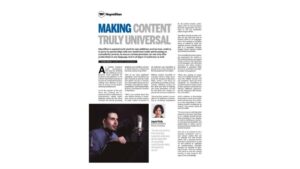When it comes to making content accessible to the d/Deaf and hard of hearing, there are two alternatives: closed captions (CC) and subtitles for the deaf and hard of hearing (SDH). Two services that serve the same purpose, but are not alike. Quite on the contrary: they have several differences, although they are not always easily detected.
The lack of standardization is one of the reasons why telling CC and SDH apart can be rather tricky at times. Before going into the differences between the two services, let’s see what they have in common.
Both services aim to make audiovisual content accessible to people with hearing loss. To achieve this goal, Closed Captions and SDH include not only a transcript of the on-screen dialogue but also sound-related information, e.g., door closing, music, whispering, etc. This way, they are enhancing the viewer’s understanding and experience of the content. Speaker identification also contributes to this end, as it helps the deaf and hard of hearing follow the dialogue when more than one person is featured in the video.
The fact that closed captions and SDH convey all the information transferred by the auditory channel is what differentiates them from subtitles, which are a transcript/translation of the dialogue alone and should not be mistaken for an access service.
And this is where similarities conclude and differences begin, as Closed Captions and SDH don’t share the same standards and specifications.
Differences between Closed Captions and SDH
Appearance
A difference that is easily spotted is their diverse appearance. Closed captions are usually white text on a black background, while SDH’s appearance varies, as font size and color are customizable. More specifically, colors are often used to identify who is speaking, with cyan, yellow, green, magenta, and red being the ones commonly used to this end. The reason why these colors are preferred is that they are easily discernible.
It is worth noting that color coding for speaker identification is best to be used for content with up to 4 main characters, with a different color being assigned to each speaker. However, that is not always the case. BBC, for instance, suggests that if there are several main characters, the same color could be assigned to two speakers, as long as they don’t appear on-screen simultaneously.
Placement
As far as position on the screen goes, SDH are usually positioned at the bottom of the screen, similar to subtitles. On the contrary, Closed Captions’ position on the screen can vary. For example, they may be placed on the left side of the screen to show that the audio is originating from the left/ from the speaker on the left.
Accuracy
Closed captions support up to 32 characters per row, while the limit for SDH goes up to 42 characters per row. The additional 10 characters per row allow for a more verbatim transcript, as less information needs to be omitted to respect the character limit.
Synchronicity
Closed captions are timed tighter to the audio compared to SDH.
Encoding
Differences between closed captions and SDH are to be spotted on a more technical level as well. Closed captions are encoded as a stream of commands, control codes, and text. They are not supported through HDMI, but they are supported through Teletext, which makes them the right choice for content destined for a traditional broadcaster.
SDH, on the other hand, are typically encoded as bitmap images or a series of pixels and are supported by streaming internet videos and HDMI. Thus, they are usually the service of choice for content to be featured on a VOD platform.
|
CC |
SDH |
|
Usually, white text on black background |
Use of colors |
|
Located on different parts of the screen |
Usually located at the bottom of the screen |
|
Up to 32 characters per row |
Up to 42 characters per row |
|
Timed much tighter to the audio |
Timed less tightly to the audio |
|
Not supported by HDMI |
Supported by streaming Internet videos and HDMI |
| Encoded as a stream of commands, control codes, and text |
Encoded as bitmap images or a series of pixels |
While both closed captions and SDH aim to make content accessible to the deaf and hard of hearing, they are distinct services, with different advantages. Which one to choose depends on the content, each country’s accessibility requirements and regulations, as well as the preferences of the target audience.







